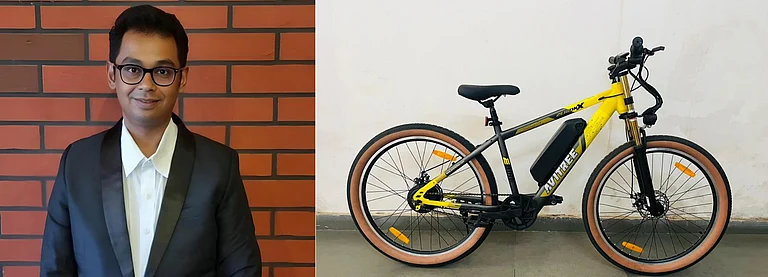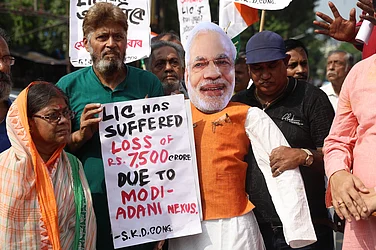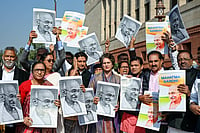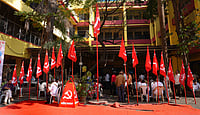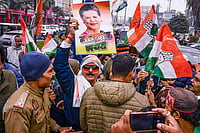
Urban redevelopment and anti-encroachment drives have displaced thousands of families, leaving many homeless and living in makeshift shelters under hazardous conditions.
Dalits, Adivasis, Muslims, migrant workers, and daily wage labourers are disproportionately impacted, with women, children, and the elderly facing heightened risks of poverty, malnutrition, and mental health crises.
Despite landmark judgments like Olga Tellis vs. BMC recognising the right to livelihood, evicted residents rarely receive dignified rehabilitation, while minor offences by homeless individuals often lead to criminalisation.
TW - Suicide, Homelessness, Chronic Hunger
“Eton(ईंटो) se mahal banane,
paseena Bahaya Hamane,
Dhanvan (धनवान) ko mili Suvidha
Sukh Chain Bhulaya hamane
Apna hi rahane ka tapara (टपरा) nahi ban raha hai
Ye Samanti (सामंती) Raj Hai Bhai,
Khane ko Khana nahi
Peene ko Pani nahi
Rahne ko ghar nahi!
Bacchon ko school nahi,
Ye Kaisa Raj Hai Bhai?”
'Bombay Our City’ or Hamara Shahar, a documentary by Anand Patwardhan, begins with poetry sung by the poor who suffered Mumbai’s housing crisis during the 1980s. This 50-year-old visual documentation captures the trauma of forced demolitions, poverty, and the feudal nature of the state. Not much has changed today, except for the ‘high rise’ of forced evictions, demolitions, displacement of the poor, and the weakening of housing rights for India’s marginalised communities.
These injustices appear in different forms: in some places, it is the ‘Bulldozer Raj’; in others, it is labelled ‘good governance’—clearing shanties on footpaths under the cover of decades-long legal battles. Across urban India, people continue to become homeless due to redevelopment projects.
In July, Outlook reported on the demolition drive in JaiBhim Nagar, Mumbai, during heavy rain. JaiBhim Nagar, a working-class slum in posh Powai near IIT Bombay, was home to around 80 families of Dalits and nomadic tribes who had largely migrated from Maharashtra’s drought-prone Marathwada region. A few Muslim families were also affected.
When Outlook followed up the story, it was found that even today 50–60 per cent of families are living on the pavement of 90 Feet Road, in makeshift shanties made of tarpaulin and plastic. The rest were displaced, with some returning to their hometowns and dozens migrating to other states to survive. Two people died by suicide during Diwali, a tragic consequence of homelessness, unemployment, and chronic hunger—issues that are only a few among many
Lives after demolitions
When New York’s newly elected socialist mayor, Zohran Mamdani, made headlines, youth around the world, including in India, applauded one of his key campaign promises: affordable housing. Many drew inspiration from his message, often asking, “Who builds cities? Who built New York? Immigrants, the working class.”
Meanwhile, on the other side of the world, a young Gen-Z man lived on the pavements of Brooklyn Heights, Mumbai—Hiranandani Township, adjoining the JaiBhim Nagar slums. Ravinath Kurhade, 24, once had a 100-square-foot home in JaiBhim Nagar, built by his migrant parents with immense hardship. In 2024, it was demolished by the BMC as illegal encroachment. He rebuilt a makeshift shanty on the footpath, only for it to be demolished again in July 2025.Lost in the darkness of an existential crisis during Diwali, he died by suicide. He had no food, no internet, no Instagram to offer hope, distraction, or comfort—nothing of the urban life others take for granted reached him. Kurhade is survived by his elderly parents and four sisters. His neighbours, all homeless, struggled to arrange his funeral.
His sisters lost him on the very day most of India was celebrating Bhaubij/Bhaidooj, a festival that traditionally honours the bond between brothers and sisters. Unable to afford mourning or healing, the Kurhade family returned to Nanded. Life resumed for everyone—daily wage work continued—except the father, who remains hospitalised, shattered by trauma.Before the history of chaotic urban demolitions and development erases these lives entirely, read another story: Suresh Kamble, 40, also faced eviction in Jai Bhim Nagar. Two generations of his family had worked to build the high-rises of Powai. Kamble died by suicide in his shanty during Diwali. He is survived by three children, now cared for by relatives, after his wife left him months earlier under the weight of poverty and homelessness.
The big Picture
Housing and Land Rights Network’s (HRLN) research titled ‘Forced Evictions in India 2022-2023’ documented demolitions of over 107,449 (1 lakh homes) resulting in the forced evictions of at least 5,15, 772 (5 lakh) people. ‘Most evictions were carried out under the guise of city beautification, encroachment removal, or development projects - often without prior notice, consultation, or provision of alternative housing. The reports reveal that authorities frequently bypass legal safeguards under national and international human rights frameworks. Those most affected belong to marginalised communities — including Dalits, Adivasis, Muslims, migrant workers, and informal sector labourers — who already face systemic discrimination and housing insecurity. Even when resettlement was offered, barely a quarter of displaced families received it, and most were relocated to peripheral areas lacking basic amenities.’ according to HRLN’s research report.
Women’s vulnerabilities
“I have seen only darkness this Diwali. I watched our people die in front of me. Those who survived went days without proper food—festival celebrations are impossible. Our children dropped out of school, fell sick from lack of food, water, and sanitation. Some students from IIT Bombay helped for a few days with basics and solidarity. Now we are on the verge of dying. What choice do I have but suicide? The courts and media do not hear us,” says Meena Nimbole, one of the homeless in Jai Bhim Nagar.Nimbole fought a court case against the Brihanmumbai Municipal Corporation (BMC) over the demolition of their homes. Representing the collective voice of evicted residents, she failed to secure a stay or interim relief after the Bombay High Court ordered BMC to clear their homes as encroachments in the Tivoli Housing Society vs Municipal Corporation of Greater Bombay case. Tivoli, a posh Powai high-rise, had petitioned for the removal of alleged footpath encroachments, claiming they blocked public access.“Nobody—from civic officials to local politicians—is helping us. Our people are pushed to the edge of sanity by relentless stress. What option do we have but suicide?” Nimbole asks.
In July 2025, Outlook interviewed Sonia Shivsaran, eight months pregnant and recently evicted. With no options and under severe financial strain, she returned to her hometown in Nanded to give birth. Her parents and husband, all daily wage workers, now struggle to survive. Yet this forced reverse migration spared her newborn son from homelessness; at two months old, he at least has a roof over his head.
Another victim, Rupa Pawar, 22, was seven months pregnant when neighbours helped her return to Narasi Naigaon in Nanded with a small crowd-funded sum for travel. Already mother to two daughters, she gave birth to her third child a month ago. Weak, anaemic, and mentally stressed from life on the streets, she was categorised as high-risk and underwent a C-section. Her family borrowed Rs. 2 lakh from a contractor and now work as bonded cane cutters to repay the debt.
Redevelopment Projects and displacement
The BMC’s proposed connector bridge project between Yari Road, Versova, and SVP Nagar recently led to the eviction of 40 households who had lived there for over two decades.“While the civic body has Bombay High Court approval to cut mangroves and promises compensatory afforestation, it has ignored the residents’ rehabilitation. Many of these families helped build SVP Nagar and now provide essential sanitation and domestic services. Despite being entitled to resettlement under the Maharashtra Slum Act, 1971, they were evicted under the Maharashtra Land Revenue Code, exploiting legal ambiguities to displace people,” says Janhakka Andolan, a Mumbai-based collective.
Between 2022 and 2024, several Indian states, including Delhi, Uttar Pradesh, Madhya Pradesh, Assam, and Gujarat, witnessed large-scale demolition drives by municipal and state authorities. Often described as anti-encroachment actions, these operations destroyed thousands of homes and small businesses. In many cases, residents received little or no prior notice, raising serious concerns about procedural violations and the humanitarian impact of such evictions.
Decline of Rights-Based Housing Jurisprudence
The Olga Tellis vs. Bombay Municipal Corporation (1985) case is a landmark Supreme Court judgment that expanded the scope of the Right to Life under Article 21 of the Constitution. Journalist Olga Tellis and others challenged the BMC’s eviction of pavement and slum dwellers in Mumbai, arguing that the right to livelihood is integral to the right to life. The Court upheld this, recognising livelihood as part of life itself. However, it also allowed the state to remove encroachments under certain conditions, balancing humanitarian concerns with urban governance. Yet the assurance of shelter or dignified rehabilitation for evicted residents remains far from reality.
Outlook spent days following up on past demolition stories to answer a critical question: where do urban India’s poor go after forced evictions? On November 6, Gutam Khanna, 46, shared his plight for over an hour. A migrant from Lucknow who moved to Mumbai in 1997, Khanna spent years helping build Versova. A week ago, he and 32 other families were evicted. Now he lives in a makeshift tent shared by dozens of families, entirely dependent on donors, activists, and a nearby Gurudwara for food.“I could not bathe for seven days. We have only a plastic roof and no sanitation. We are forced to defecate near the creek. My body started itching,” Khanna said.“Those evicted and displaced live on the margins or are pushed beyond city boundaries. They often lose their dignity as human beings. Providing just rehabilitation is the least governance can do—but it rarely does,” says Shubham Kothari of Janhakka Sangharsh Samiti, Mumbai.Some homeless people take shelter at bus stands or railway stations, only to be criminalised.
Minor offences are punished disproportionately, and some are made scapegoats in cases where investigations fail.People who become homeless due to demolitions take shelter at bus stands or railway stations, only to be criminalised. Minor “offences” are often punished disproportionately, and some are made scapegoats when police fail to conduct proper investigations. In 2023, an elderly homeless woman in Pune was arrested for stealing a single tap from a railway station, intending to sell it as scrap to buy food, and spent several months in jail.“Much later, when the district legal aid centre learned of her case, we helped her. I assisted with her bail plea. A woman who didn’t have 15 rupees to buy a vadapav was forced to furnish a PR bond of Rs 15,000. DSLA helped, and she is finally out on bail. But the police and RPF still view her with suspicion whenever she is near a railway station or bus stand,” Aditya Shelar, a Pune-based lawyer, told Outlook.
Footnote: Those who are struggling with mental health issues, stress or suicidal thoughts can reach out to Telemanas helpline and avail support from professionals for free of cost - Telemanas/ 14416








